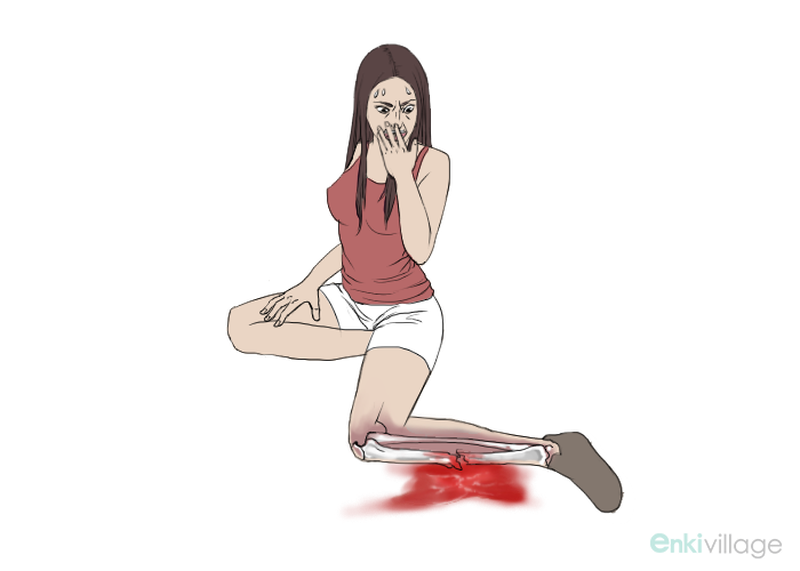An open fracture is a dangerous type of injury because it is often associated with other types of body trauma. Its severity may vary from a small visible wound to overt physical trauma that shows seriously damaged bones, muscles, blood vessels and nerves. Open fractures involve broken bones that are exposed to the environment and are at risk for contamination and infection.

What Is an Open Fracture?
An open fracture is a broken bone that penetrates the skin. Compared to a broken bone that does not pierce the skin (a closed fracture), an open fracture increases your risk for infection. Therefore, immediate treatment is necessary to clean the affected area and prevent infection. Furthermore, compared to a closed fracture, an open fracture is often more likely to be associated with prolonged healing.
Open fractures are often caused by trauma involving strong impact, usually sustained from a direct blow. This may involve a fall or collision involving a motor vehicle. They may also result from indirect trauma, such as high-energy twisting types of injury.
Possible Complications of Open Fracture
Infection
Because of tissue exposure, you are at risk for wound infection and bone infection (osteomyelitis).
Tetanus infection is another risk involved in open fractures. In severe cases, the rate of infection from bacterial contamination remains as high as 20%, depending on the associated injuries to the soft tissues, as well as the effectiveness of initial management.
Bacterial contamination to the wound at the time of injury and hospital-acquired microbes increase your risk for infection.
Other Complications
Other possible complications include non-union of the broken fragments of bone and chronic osteomyelitis.
Sometimes, amputation of a limb may be necessary to save your life. Failure of fixation and non-union of bone fragments will depend on various factors such as the location of the fracture and the extent of damage to the soft tissues.
Nerve and blood vessel (neurovascular) damage, trauma to other parts of the body, and compartment syndrome are also possible complications.
How to Deal With Open Fracture-Initial Treatments
Seek immediate help
Call 911 or a local emergency number when you see signs of open fracture. Serious trauma to other parts of the body may be associated with this type of injury. Quick medical care will reduce your chance of getting a wound infection and other complications.
Antibiotics and Tetanus
Open fractures must be treated with antibiotics as soon as possible, even while you are in the emergency room. The type of antibiotics used may depend on the severity of your injury. If you have not had a booster shot for tetanus within the last 5 years before your injury, you will need to receive a tetanus shot.
Injury Stabilization
Initially, your injured limb will be covered with sterile dressing. Your broken bones may be gently aligned to prevent further damage to the soft tissues. A splint may be applied to stabilize the injured limb to keep it from further movement before surgery.
Débridement and Irrigation
Cleaning or débridement is performed by your surgeon to remove any dirt, foreign bodies or contaminated or unhealthy skin, muscles, and other damaged soft tissues. This may also include foreign materials like small unattached or contaminated bone fragments. After débridement, your wound is generously irrigated and cleansed with plenty of saline solution.
Open Fracture Fixation Treatment
Internal Fixation
Surgical treatment consists of internal fixation, which involves repositioning of the bone fragments to normal alignment using medical screws, plates and rods made of surgical grade metal.
Aside from broken bones, soft tissue injury must also be treated. Surgical procedure may be prolonged and your surgeon may take into consideration whether or not you can tolerate the procedure.
External Fixation
In some cases, your doctor may also perform external fixation, which holds your bones in alignment using external pins and screws, which are placed above and below the fractured site. Then the orthopaedic surgeon repositions the bone fragments. These pins and screws are connected to metal bars outside your skin to provide a stabilizing frame which holds your bones in proper position.
Minor Fractures
Minor open fracture with minimal contamination may be stabilized using internal fixation after débridement.
Severe Fractures
A severe open fracture is first stabilized by external fixation to keep the broken bones in place until internal fixation can be tolerated.
Complex Wounds
In some cases, significant soft tissue damage prevents wound closure with stitches. These complex wounds may be covered with various methods.
A local flap of a nearby muscle tissue from the limb may be rotated to be used as covering for the open fracture. A healthy patch of skin harvested from another area (graft) of the body may be placed to cover this.
A free flap that comes from another part of the body such as the abdomen or the back may be transferred to cover the large opening. This procedure is performed with the help of a microvascular surgeon who ensures proper connection of the blood vessels and establishment of circulation.
Temporary coverage of complex open fractures is necessary to decrease your risk of infection and promote healing. Various types of wound dressings can be used, and a semipermeable material may be preferred until soft-tissue closure is done. Your doctor may also place antibiotic beads containing high concentrations into the wound before sealing it to provide the body added protection.
Note: An open fracture may take a longer time to heal because of the large extent of injury and the high rate of complications associated. Timely treatment consisting of cleaning, antibiotics and stabilization of bones will help reduce your risk of other associated problems.

View All Comments /Add Comment